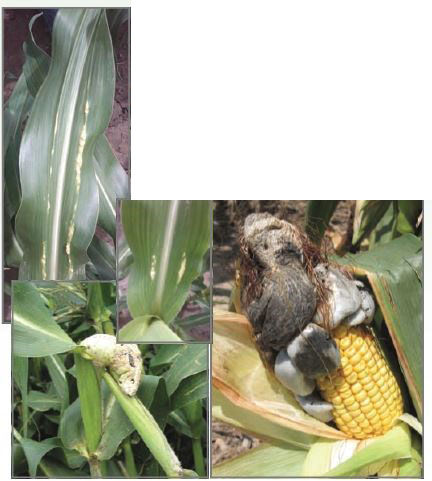2 READ-TIME
Common Smut
March 31, 2020
Common smut, caused by the fungus Ustilago zeae or Ustilago maydis, can be found in corn fields every year, but does not typically cause major economic damage. However, when the three parts of the disease triangle come together, (the fungus, susceptible host, and favorable environmental conditions) high levels of infection may occur, which can cause potential yield loss.
Symptomology
Common smut causes smut balls or galls to develop (Figure 1). Any portion of the plant may become infected, but yield loss is greatest when the ear is infected. Smut balls have a silver or white appearance as they develop. As they mature and dry out, they become black and release spores.

Figure 1. Common smut can infect leaves, stalks, and ears. Infection can occur throughout most of the growing season. Some infection occurs through the silks, while other points of entry are caused by hail, greensnap, or insect injury.
Life Cycle
Common smut overwinters in soil and can remain viable for several years. Spores from common smut are most often spread by wind. With warm, moist conditions, infection can occur in corn leaves, stalks, tassels, silks, or ears. Infection rates can be higher when drought stress during flowering results in poor pollination. Silks that have not pollinated remain susceptible to infection for an extended period of time. Poor pollination, caused by a drought, that is followed by warm, moist conditions, significantly increases infection potential. Additionally, any damage from insects, wind, cultivation, herbicide, animals, or hail can create an entry point for the fungus and increases the likelihood of infection.
Management
Fungicides do not effectively control common smut. Crop rotation is not a feasible option because the fungus can remain viable in the soil for several years. In fields with high levels of common smut, deep tillage can bury the fungus, which can help reduce the level of inoculum available for next year. Hybrids can show different levels of infection. Some of the variance among hybrids is due to different levels of genetic resistance; however, the majority of the variance can be attributed to hybrid response to drought conditions during pollination and silking. Planting a package of hybrids with different maturities and different growing degree unit requirements to flowering can help stagger pollination in a farming operation. Therefore, if drought or heat stress occurs during a portion of pollination, it is less likely that all of the acres in that operation would be affected. Managing the risk for poor pollination can help reduce the risk of smut infecting the ear, which is where it is most likely to cause potential yield loss.
Sources:
Miller, S.A. et. al. 1996. Common Smut of Corn. The Ohio State University Extension. Fact Sheet HYG-3119-96. http://ohioline.osu.edu/ (verified 8/11/2010).
Munkvold, G. 2001. Common Smut more common than usual. Iowa State University Extension. Integrated Crop Management. www.ipm.iastate.edu/ (verified 8/11/2010).
